No matter how pristine your car’s bodywork looked when you bought it, corrosion is inevitable, and sooner or later rust will rear its ugly orange head. Father time is undefeated and this is a matter of when, not if. The trouble is there’s barely a component on your vehicle’s exterior that’s safe from rust, and in addition to being unsightly, it can affect performance, safety, and resale value.
Of course, the best cure is prevention. While treating existing rust helps, you must act proactively to prevent further corrosion from occurring. The good news is that this is often a relatively low-cost DIY job. In most cases all you need is an aerosol spray can and truthfully, you’re spoiled for choice. Here’s our guide to the best rust prevention sprays for cars in 2025.
- Factors to Consider in Rust Prevention Sprays for Cars
- Top 10 Best Rust Prevention Sprays for Cars 2025
- 1. Best Overall Rust Prevention Spray Rust-Oleum Rust Reformer
- 2. Best All-Purpose Rust Prevention Spray Corroseal Rust Converter Metal Primer
- 3. Best Budget Rust Prevention Spray Fluid Film Lubricant & Corrosion Inhibitor
- 4. Best Premium Rust Prevention Spray 3M Professional Grade Rubberized Undercoating
- 5. Best Rust Prevention Topcoat Rust-Oleum Stops Rust Spray Paint
- 6. Best All-in-One Rust Prevention Spray Rust Bullet Automotive
- 7. Best Professional Rust Prevention Spray POR-15 Rust Preventive Paint
- 8. Best Rust Prevention Spray for Small Parts Boeshield T-9 Rust & Corrosion Protection
- 9. Best Complete Rust Prevention Kit POR-15 Stop Rust Kit
- 10. Easiest Rust Prevention Spray to Apply WD-40 Specialist Long-Term Corrosion Inhibitor
- Guide to Buying the Best Rust Prevention Sprays for Cars
- Frequently Asked Questions
- Prevention Is the Best Cure
Factors to Consider in Rust Prevention Sprays for Cars
When it comes to rust prevention sprays there’s no shortage of options, but each one works a little differently. For a detailed break-down of these different product types, we’ve created a ‘Knowing Your Options’ section later in this guide.
Don’t worry, though: our product reviews include rust prevention sprays that deal with all types of corrosion, and will satisfy beginners as well as more seasoned automotive hobbyists. We’ve even included a top professional-grade option, for mechanics on the lookout for a new go-to shop treatment.
To help you pick the best rust prevention spray for both your circumstance and experience level, here are some key factors you should consider before buying:
Method of Action
Many rust treatments available are designed solely to remove existing rust. For us, that’s not good enough. Rust occurs when iron and oxygen react in the presence of water, or moisture in the air (read more about the rusting process). As there’s little escape from oxygen and water, new rust will continue to form. Only focusing on removing rust is like fixing a faucet in a burning building. If there’s no rust prevention mechanism in a product, it didn’t make our list.
Surface Suitability & Adhesion
Water-based treatments are typically less toxic and easier to clean, and thus more beginner-friendly. Still, if you’re looking to boost performance, you’ll typically want to increase lubrication, in which case an oil-base is preferable. Some rust prevention sprays can be applied directly over rusted areas, whereas others require a lengthy cleaning and degreasing process to prime the surface. Take note of the surfaces you wish to treat, and ask yourself how much effort you’re willing to put into preparing these.
Corrosion Resistance
Even the best prevention sprays can’t be expected to last for a lifetime. Still, you need a spray that can withstand your lifestyle behind the wheel, whether that’s navigating brutal winter months or frequent off-road driving. Although we advise regular maintenance check-ups, you should choose a spray that offers at least 1 year of corrosion protection.
Ease of Application
Imagine lying under your car to coat the undercarriage with your brand new rust prevention spray, only to find the nozzle clogs when held horizontally. Nightmare! We love to see adjustable spray-angle cans or special attachments for hard to reach places. Some options on our list come in a paint can rather than an aerosol. These products can be connected to a spray gun, which is a big time-saver if you have one. If not, you’ll have to dig out the paint-brush or roller, which can be much more time-consuming.
Coverage
Rust prevention sprays vary widely in their viscosity, so there’s significant product variance in how much coverage they’ll give. This is a particularly important consideration if you’re looking to rustproof large vehicle panels or the entire undercarriage of your car.
PRO-TIP: most brands note an expected coverage for their spray, given in square feet. We advise you to take stock of the size of the area you wish to cover, then double it to find what you need. Why? Most areas will need at least two coats.
Finish
For many, the aesthetic horror of corrosion is their primary reason for rustproofing. If this sounds like you, you may well consider the visual finish of a product to be a deal-breaker. Some rust prevention products are designed to act as a topcoat, with glossy and matte choices. Others must be painted over to look good. A few aren’t intended to be used on visible areas at all. Not to worry, our product reviews note all color variations, and whether the product can be used as a topcoat, or will require further work.
With these factors in mind, it’s time to break down our picks for the 10 best rust prevention sprays for cars, in 2025.
Top 10 Best Rust Prevention Sprays for Cars 2025
1. Best Overall Rust Prevention Spray Rust-Oleum Rust Reformer
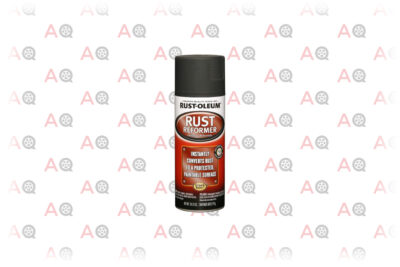
Editor’s Rating:
Method of Action
As well as preventing future corrosion, this reformer solution binds to existing rust and transforms it into an inert polymer, leaving you with a black, paintable surface. This saves you from undertaking a lengthy rust-removal process for parts that are already showing wear and tear. As such, it’s a beginner-friendly, dual-action treatment that’s ideal for rust on car parts that can’t easily be soaked in rust removal solution.
Surface Suitability & Adhesion
Designed to be applied to areas already showing surface rust, we find the Rust Reformer spray is suitable for rusty spots both inside and outside your vehicle. This spray is so effective at reforming existing rust that you needn’t waste hours prepping the surface, just a quick clean to remove dirt, grime, and loose rust will do the trick. This is ideal for those with less experience or who don’t want to spend hours on prep work.
Corrosion Resistance
As this spray is designed specifically for automotive use, the corrosion resistance is excellent and it stands the test of time against pressure washing, daily sun exposure, and regular wear and tear from the road. In our experience, even without a topcoat, you can expect the rust protection will hold for 12-18 months. Still, for protection 5+ plus years, you should apply a topcoat of paint to seal it in.
Ease of Application
Rust Reformer comes in an ‘any-angle spray with comfort tip’ aerosol can. This makes it perfect for hard to reach areas, like the vulnerable underbody area of your vehicle. It’s also a distinct advantage over rust prevention treatments that aren’t made for automobile use – these can often only be sprayed effectively from a vertical position. This is significantly more toxic than regular paint, though. So while it’s easy to apply for beginners, you must do so in a well-ventilated area and wear a respirator mask to avoid inhaling the vapors.
Coverage
We find that the best results come from applying repeated thin coats, at 24-hour intervals. This gives a cleaner finish and is more economical, as it prevents over-painting. Unfortunately, the spray only comes in one size and you may find that you need multiple cans to get the job done.
Finish
Rust Reformer is matte black, so bear this in mind when picking your topcoat. It will take at least two thick coats to fully cover. Perhaps even three if you’re using a light topcoat shade. Overall, we believe that the extra effort of applying a topcoat is worth the incredible rust prevention this spray offers.
Pros
- Unrivaled corrosion resistance
- The dual-action method reforms existing rust as well as preventing it
- Spray tip design makes it easy to apply to vehicle undercarriages
- Doesn’t require time-consuming prep or rust removal
Cons
- Can take several thick coats of paint to cover, requiring multiple cans
- Toxic and must be applied with good ventilation
2. Best All-Purpose Rust Prevention Spray Corroseal Rust Converter Metal Primer
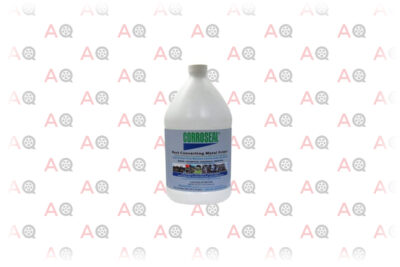
Editor’s Rating:
Method of Action
Corroseal is a multi-function corrosion inhibitor solution. The active ingredient, Gallic acid, primes and converts rust, as well as offering future rust protection, all in a single step. Just like the Rust Reformer, it’s intended to be painted over as extra protection against future rust. The multi-function nature of Corroseal means it’s cheaper, simpler, and more time-efficient than many other options.
Surface Suitability & Adhesion
Corroseal is suitable for application to almost all metal surfaces. It works exceptionally for automotive parts, but can also be used on garden tools, industrial parts and in marine environments. As a result, it’s perfect to keep around the home for regular touch-ups and isn’t the kind of product that will sit half-empty on your shelf for years.
Corrosion Resistance
Corroseal is highly durable and corrosion-resistant, but only when applied generously. We suggest applying a coating every 15 minutes for 1 hour and then boosting with a thick, final coat. You also need to keep away from rainfall during this process. As Corroseal is a water-based solution, rainfall will quickly pull off any wet coating.
Ease of Application
The surface will need some light preparation first; we find a once over with rubbing alcohol usually works a treat. As well as a spray application, you can also apply it with a brush or roller. Being able to switch application methods for different car parts is handy, but you’ll need to use your own spray head as it doesn’t come in an aerosol can, which may be a significant disadvantage for you. We love the water-based formula as you can easily clean up any spillages with soap and water. Plus, the water-base means any excess application drips straight off, helping to avoid an uneven appearance.
PRO-TIP: if planning to use a brush or roller, don’t return any excess solution to the bottle once finished. Doing so can compromise the rust prevention properties and spoil the rest of the solution.
Coverage
Corroseal comes in 3 different sizes (1 quart, 1 gallon & 5 gallons). You can expect coverage of around 200-250 square feet per gallon, but we think the bottom end of that range is most accurate. Corroseal does benefit from generous application, and this is a common failure point in DIY rustproofing. Due to the water-base, it’s difficult to overdo it by accident, so don’t be shy.
Finish
It needs 24 hours to fully cure, then you’re good to go. Once dried, Corroseal leaves metal with a smooth black finish, ready to be painted over. Nothing fancy, but it does the job well.
Pros
- Very versatile, can be used on more than just cars
- The dual-action converts existing rust and prevents future rusting
- Water-base makes application simple for beginners
- Can be applied with spray, brush or roller
Cons
- Spray head requires separate purchase
- Requires generous coating
3. Best Budget Rust Prevention Spray Fluid Film Lubricant & Corrosion Inhibitor

Editor’s Rating:
Method of Action
Unlike the Rust Reformer and Corroseal, Fluid Film won’t convert or ‘dissolve’ existing rust.
I’s not the product for you if you’re struggling with existing rust. However, it does an amazing job of preventing future rust formation on exposed metal. It’s also a lubricant, so it can be used to address smaller, moving parts and prevent rust from affecting performance.
Surface Suitability & Adhesion
Fluid Film is lanolin based, and this comes with a few distinct advantages. Firstly, you can safely apply it to plastics and rubber, as well as metal. You don’t need to obsess about dripping or minor spillages, as you’re unlikely to cause lasting damage. Plus, the solution won’t evaporate over time, making its adhesion phenomenal. It isn’t suitable for rustproofing large visible areas like the car body framework, though.
Corrosion Resistance
Fluid Film was designed for the highly corrosive marine environment, for use on ships and drilling rigs. So it’s no surprise that it holds up exceptionally well when challenged with preventing corrosion in car and truck metal, surfaces much less exposed to moisture. To be clear, this is the most durable product on our entire list.
Ease of Application
The spray bottle comes with a removable nozzle attachment, perfect for treating difficult areas like door hinges or trunk latches. However, we do find the nozzle is prone to clogging when used for extended periods. This is usually solved by a quick rinse of water and is a non-issue if you’re just doing odd touch-ups. But it can get a little frustrating if you wish to rustproof your entire vehicle in one go. More positively, Fluid Film is non-toxic, making it suitable for users who don’t have professional protective equipment.
Coverage
Fluid Film is intended as a protectant for small areas that, in addition to rusting, are prone to becoming stiff or squeaky. When used in this way, you’ll find one 11.75 oz can lasts a considerable amount of time and makes this our best budget pick. You can also use the spray more liberally on the underside of your car or truck, just don’t expect it to last too long.
Finish
Fluid Film adds a glossy shine when applied. We like this as it becomes obvious which areas have been adequately covered and where you need to apply more product. Still, it’s not suitable for visible surfaces where you need a premium looking finish.
For these areas, a product such as Rust-Oleum Stops Rust Spray Paint would work better.
Pros
- Can be used on many different surface types
- Highly resistant to future corrosion due to lanolin base
- Effective lubricant, ideal for small car parts
- Great long-lasting budget choice
Cons
- Doesn’t treat existing rust
- Nozzle tends to clog
- Not suitable for visible areas
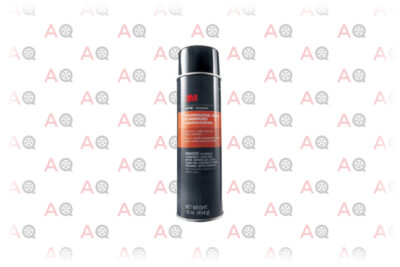
Editor’s Rating:
Method of Action
This 3M product is a professional-grade rubberized undercoating. It’s made to protect against chips, dirt, and corrosion on the undercarriage of vehicles, but can also be used on wheel wells, fenders, and quarter panels. It’s a single-function product but is exceptional for its purpose. It even has sound-deadening properties, insulating your vehicle, and helping to reduce road noise.
Surface Suitability & Adhesion
3M is not suitable to be applied over rust. If you already have a rust problem you’ll need to remove this manually or opt for an all-in-one solution like Rust Reformer. 3M is better suited for car nuts who are looking for high-level protection on a vehicle that’s already in good shape. It adheres very well to clean metal, but you will need to thoroughly prep the surface beforehand.
Corrosion Resistance
3M claims to effectively keep out any grime or moisture that could corrode metal components over time. In our experience, this claim is spot on. We find that 3M can keep an undercarriage rust-free for the long-term, even on cars and trucks that handle frequent off-road driving, or are routinely exposed to adverse weather.
Ease of Application
It comes in an aerosol spray can and requires no additional equipment. Unfortunately, it’s easy to overspray and tends to stick. For that reason, it’s best suited for those with a spacious set-up, where you can lay down drop cloths on the flooring beneath your vehicle. You also need to hold the can as vertically as possible as this aerosol doesn’t perform great as a horizontal angle.
Coverage
3M comes in a 16 oz can, which is well-priced. The problem is you will need a whopping 8-10 cans to undercoat your entire vehicle. The premium finish it offers is reflected in the cost, and this is an option suited to those with a bigger budget.
Finish
This undercoating leaves your ride with a premium-looking, textured black coating. The finish is truly beautiful and tops our list for undercarriage style points. If you’re a car-lover who’s as obsessed with appearance as you are with function, this is where to spend your money.
Pros
- Beautiful, professional-grade finish
- Holds up against poor weather conditions
- Includes unique sound-deadening properties for quieter driving
Cons
- The aerosol can is easy to over-spray
- The aerosol clogs when held horizontally
- Can be expensive as a full undercoating requires multiple cans
5. Best Rust Prevention Topcoat Rust-Oleum Stops Rust Spray Paint

Editor’s Rating:
Method of Action
The Rust-Oleum Stops Rust Spray Paint is primarily a topcoat paint, but one that’s enhanced with corrosion-inhibiting properties. This makes it perfect for vehicle exterior paint jobs such as bumpers or wheels, as it combines rust protection with a striking visual finish.
It’s also the perfect supplement for heavy-duty corrosion inhibitors that require a topcoat, such as Rust Reformer, also offered by the Rust-Oleum brand.
Surface Suitability & Adhesion
This spray paint is not suitable for application over existing rust areas, and should only be used on pre-treated surfaces that have already received a coat of primer.
Corrosion Resistance
Don’t expect this spray paint to fully rustproof your car or truck for years, especially if it’s regularly subjected to rain, snow, or dirt. We consider this to be the number 1 rust-preventative paint on the market: but remember that it is primarily a paint, not a corrosion inhibitor. For full protection, use this as a finishing overcoat, on top of an all-in-one product.
Ease of Application
Similar to the Rust Reformer, this spray comes in an ‘any angle’ spray can. The can also has a ‘comfort tip’ spray head. Essentially, this means the finger pad is wider than on a typical can and requires only a small amount of pressure. We love this feature for bigger spray jobs – it’s surprising how much your fingers can fatigue.
Coverage
Each can should cover up to 15 square feet. To put that in more practical terms, this is just about enough to double-coat four car wheels. Overall it’s a moderately priced option and as it’s multi-purpose spray paint, any excess can be used to touch up other household items or small appliances, too.
Finish
This spray offers an extremely high-quality finish and comes with a choice of over 20 different colors, including both flat and glossy options. This is by far the biggest color range we’ve seen and makes it easy to find a match for any pre-existing color scheme your car may have.
Pros
- High-quality finish
- Easy to use spray button
- 20+ colors available
Cons
- Not a heavy-duty rust protectant
- Doesn’t treat existing rust
6. Best All-in-One Rust Prevention Spray Rust Bullet Automotive

Editor’s Rating:
Method of Action
Rust Bullet Automotive is a true all-in-one corrosion inhibitor product. There’s nothing else on the market that covers as many bases. It’s a polyurethane coating and the only product that can be applied directly to surface rust while simultaneously also functioning as a water-insoluble primer, primer, and a UV-proof topcoat.
Surface Suitability & Adhesion
Rust Bullet was specifically developed for automotive applications and works on undercarriages, framers, floor pans, suspension, and can even be used for the main car body. It should only be applied to metal, but it doesn’t matter if this metal is rusty or is clean – it works on both.
Corrosion Resistance
One feature unique across all of our product reviews is Rust Bullet’s protection against the ultraviolet (UV) light degradation of steel. This UV resistance helps ensure the paint won’t crack over time, limiting the opportunity for rust to take hold. Just make sure that you wait 72 hours after application before you start exposing your vehicle to the elements.
Ease of Application
Like Corroseal, Rust Bullet can be applied with a brush, roller, or spray. Plus, as it can be applied directly to rusty metal and doesn’t need an additional topcoat, Rust Bullet offers the most time-efficient application process of all products and is ideal for the less experienced. However, it comes in a wide-lid paint can and can’t be used as a spray unless you have an HVLP Spray gun – a simple pump sprayer won’t work.
Coverage
Rust Bullet Automotive comes with a choice between 8 different sizes, ranging from ¼ pint to 5 gallons. This is the biggest quantity choice we’ve seen in a rust prevention product and you should find it much more convenient than buying 8+ cans, as you may need to with the 3M spray.
Finish
Rust Bullet Automotive only has one color: metallic gray. We think this looks pretty smooth (it’s a polyurethane coating), but if you’d prefer a different finish, you can still topcoat it. Just don’t feel that you need to. If you’re happy with the color, Rust Bullet is more than adequate as a top-layer. Notably, it will take 72 hours to fully cure – much longer than most options.
Pros
- Complete all-in-one solution
- UV protection for enhanced correction prevention
- Many size options
Cons
- Requires an HVLP can to be used as a spray
- Only one color
- 72 hours to fully cure
7. Best Professional Rust Prevention Spray POR-15 Rust Preventive Paint
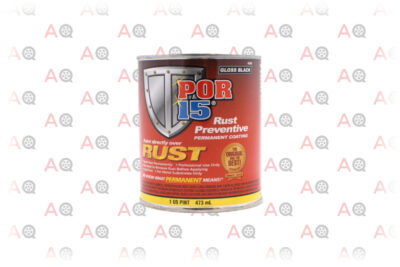
Editor’s Rating:
Method of Action
As well as preventing future rust from forming, POR-15 Rust Preventative Paint ‘seals in’ existing rust so that it is no longer visible and incapable of causing further damage. Notably, it’s the full-size version of step 3, from the POR-15 Stop Rust Kit.
Surface Suitability & Adhesion:
This paint does an outstanding job of sealing existing rust. But to create an effective seal it must adhere strongly on initial application, and this is only possible once the surface has been properly prepped. To do this, you need to treat your vehicle with POR-15 cleaner and metal prep products beforehand.
Corrosion Resistance
POR-15 claims this product gives ‘permanent rust resistance’. While we wouldn’t extend our praises quite that far, it’s fair to say this POR-15 is one the most durable rust prevention coatings on the market today. Unfortunately, it’s vulnerable to sunlight, and surfaces prone to sun exposure must be treated with an additional topcoat product.
Ease of Application
While it’s marketed as paint, you can connect to a spray gun if you wish. Be warned, though, that this product is intended for professional use only. A respirator mask is essential as it may cause lung damage if inhaled, so don’t take this warning lightly. We also find it dries very fast, and is vulnerable to high-humidity environments, making it tricky to rectify mistakes or address spillages.
Coverage
This product is available in either 1 gallon, 1 pint or 1 quart sizes. We find that compared to the competitors a small amount will go a very long way. To give an approximation, we would expect 1 gallon to cover 200 square feet for 2 full coats, which should be all you need.
Finish
You can choose between several colors ranging from clear to black, with both matte and gloss options available. The finish is rock-hard and won’t chip or peel. Surfaces that can expect prolonged exposure to sunlight should be treated with an additional topcoat product, but there’s no need to do this all over – save your money and take a pass on top coating the undercarriage.
Pros
- ‘Permanent’ rust prevention
- Seals existing rust to stop further damage
- A small amount of product goes a long way
Cons
- Only suitable for professional use
- Difficult to apply
- Vulnerable to UV light
8. Best Rust Prevention Spray for Small Parts Boeshield T-9 Rust & Corrosion Protection

Editor’s Rating:
Method of Action
Boeshield T-9 is an anti-corrosion protectant as well as a lubricant. It won’t remove existing rust and isn’t intended to provide coverage to your car’s body, but it’s incredible when it comes to lubricating the difficult to treat nooks and crannies of your vehicle and helps to stop parts from seizing up. It also has a cleaning effect and will loosen rust flakes and remove dirt as it’s applied.
Surface Suitability & Adhesion:
Boeshield T-9 is perfect for small parts like locks and window hinges. It’s even safe on electronic components, Plus, unlike the other products reviewed, if there are places on your car’s interior that are beginning to rust or stiffen, Boeshield T-9 can be used there too. That’s because it’s safe for use on top of existing paintwork, plastic and vinyl surfaces. Highly versatile surface suitability gives this product full marks here.
Corrosion Resistance
Thanks to a history of use in marine and aviation environments, Boeshield T-9 offers protection that’s more than durable enough for vehicles. It’s also waterproof, so it gives outstanding protection in environments that usually accelerate vehicle corrosion, such as salt-water and snow. Notably, we find it to be much more effective for automobile use than other popular lubricants like WD-40.
Ease of Application
Boeshield T-9 comes with a simple spray head can. Unfortunately, there isn’t a nozzle attachment for hard-to-reach areas, and we find the cans are prone to clogging. In fact, it’s not uncommon for the can to give up with around ⅓ of the solution left. This seems to be most likely once opened and left to sit for several months.
To make the most of your money, we advise you to apply immediately rather than saving for a rainy day – far from ideal though. Plus, it can be very difficult to clean. To do so, you’ll need to use a solvent or emulsifying cleaner, making it much less convenient than a product like Corroseal.
Coverage
It only comes in one 12-ounce can size, which won’t last very long, unfortunately. The longevity of the lubrication and rust prevention is solid and you won’t need to top-up the same places frequently. Still, the can runs down much quicker than is standard across other rust prevention sprays. You’ll be able to treat rust-prone areas on your entire car (once) but will need multiple cans if your needs extend beyond that.
Finish
Boeshield T-9 doesn’t have a glamorous finish, like the 3M, but that’s to be expected from a lubricant. Boeshield T-9 leaves a long-lasting waxy, paraffin coating, which dries fairly clear. A hint of residue remains, though, so don’t use this on parts that you touch regularly like door handles.
Pros
- Lubricates as well as preventing rust
- Suitable for a wide range of surfaces (and waterproof)
- Can displace loose rust and dirt as it is applied
Cons
- Cans often have application issues
- Doesn’t last long
- Difficult to clean
9. Best Complete Rust Prevention Kit POR-15 Stop Rust Kit
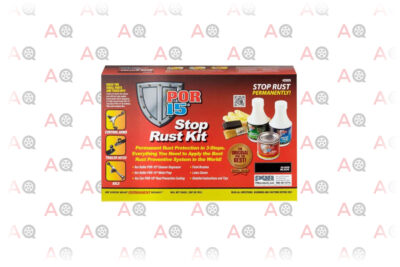
Editor’s Rating:
Method of Action
The POR-15 Stop Rust Kit is a 3-step mini-kit that contains everything you need to prevent (and treat) rusted car metal. The Cleaner Degreaser removes all grease, oil, dirt, and grime. The Metal Prep is then applied to provide an optimal adhesion surface, and the Rust Preventative Coating is then used to both treat and prevent rust. It also comes with paintbrushes, latex gloves, and detailed instructions.
Surface Suitability & Adhesion
The Cleaner and Metal Prep steps ensure optimal adhesion for the preventative coating, so you won’t need to remove any rust that remains after these steps. Generally, we find the preventative coating adheres very strongly to metal surfaces. Unfortunately, it also adheres well to human skin, so wear gloves throughout the entire application process to avoid skin damage.
Corrosion Resistance
The Rust Preventive Coating is resistant to most acids and alkalis and is capable of repelling fuels and oils. That said, it is vulnerable to UV light. No big deal for the undercarriage, but if you’re looking to rustproof something external (like door-handles) the corrosion resistance will falter without a protective topcoat.
Ease of Application
This kit size is ideal for small projects such as subframes, axle replacements, and brake shields. Plus, as it comes as a full set (with detailed instructions) you don’t need to worry about buying multiple products and whether or not they’re compatible.
Just don’t apply this product if the humidity is above 70% in your local area. With high humidity, POR-15 Rust Preventive Coating will dry too quickly and risks putting bubbles in the finish. We also find this can cause the tin to self-seal and become almost impossible to open.
PRO-TIP: if humidity is generally high where you live, try to place a thin layer of saran wrap between the tin and the lid after use. This should keep the lid from self-sealing so that it’s reusable in the future.
Coverage
If you’re looking to rustproof something small, like a brake shield, then this little kit is perfect. Expect it to cover a 6 square-foot area with two coats.
If you’re looking to rustproof your entire vehicle, you may prefer the full-sized version of the paint, POR-15 Rust Preventive Paint.
Finish
The Stop Rust Kit offers a great seal and forms very solid. There’s nothing wrong with the finish, but it won’t turn any heads, either. If you’re looking to cover visible areas, we suggest applying a separate topcoat product on top. It’s a shame there’s not one included in the kit already.
Pros
- Contains everything you need for small rustproofing jobs
- Strong adhesion
- Dries quicker than most competitors
Cons
- High humidity can cause bubbles in the finish
- High humidity can seal the tin
- No topcoat included in the kit (vulnerable to UV light)
10. Easiest Rust Prevention Spray to Apply WD-40 Specialist Long-Term Corrosion Inhibitor

Editor’s Rating:
Method of Action
This spray coats with an oil base, to lubricate and protect the metal from air and moisture. It won’t treat existing rust, but can effectively block further corrosion.
Surface Suitability & Adhesion
Recommended specifically for use in highly humid areas and winter environments, we find the oil base adheres well to metal, and we’ve never known it to damage rubber seal surfaces. Just keep well clear of any internal upholstery in your vehicle. It’s much thicker than the standard WD-40 formula which makes it better for car use, just don’t expect it to soak in as well.
Corrosion Resistance
It’s definitely a step-up from the standard WD-40 formula, but in our experience, it can’t match the level of corrosion resistance offered by Boeshield T-9, the most similar competitor.
Our recommendation would be to re-check and spray every 2-3 months, despite WD-40’s claim of 1 year of protection.
Ease of Application
This product is very simple to apply thanks to a long, extra-thin application straw made to reach hard-to-tackle areas. It also doesn’t run when applied, making application very precise.
Coverage
One can gives approximately 10 square feet of coverage. You’ll also be pleased to learn that the consistency of the spray stays uniform right until the can’s fully empty. Often with lubricants, the consistency seems to weaken for the final ¼ of the can, but that’s not the case here.
Finish
It’s slimy and greasy, but we can’t hold that against a lubricant. Overall, the coating is fairly clear and while it won’t win any awards for its appearance, it’s not going to spoil the look of your car, either.
Pros
- Consistent spray through the life of can
- Precise and accurate application straw
- Better suited to high humidity than competitors
Cons
- Will quickly stain upholstery
- Doesn’t last as long as claimed
- Won’t soak in as well as the original WD-40 formula
Guide to Buying the Best Rust Prevention Sprays for Cars
Our product reviews should have gone some way to show you why a rust prevention spray is a worthwhile investment for any car enthusiast. Just in case you’re not already 100% sold on the idea of rustproofing, let’s start our guide with a quick summary of the benefits:
What Are the Benefits of Rustproofing a Car?
Improved aesthetics: This one is simple. A rusty car is an eyesore, but you already knew that. For many people, this is justification enough.
Heightened performance: Rust also compromises the performance of your vehicle. For example, rust can increase brake pad wear and even put increased strain on engine parts, reducing combustion efficiency.
Safer travel: Rust affects the structural integrity of your vehicle and increases the likelihood of mechanical failure points. This leaves you more prone to accidents and more likely to fail road inspection tests.
Time & cost efficiency: Significant rusting buildup may require professional treatment and could leave you without a ride to work for several days. By contrast, rustproofing ahead of time can be as simple as a can of aerosol spray and half a Saturday of DIY.
Maintain resale value: Rust prevention gives you a better looking and performing vehicle for a low financial outlay. This will only help retain resale value potential if you do decide to sell.
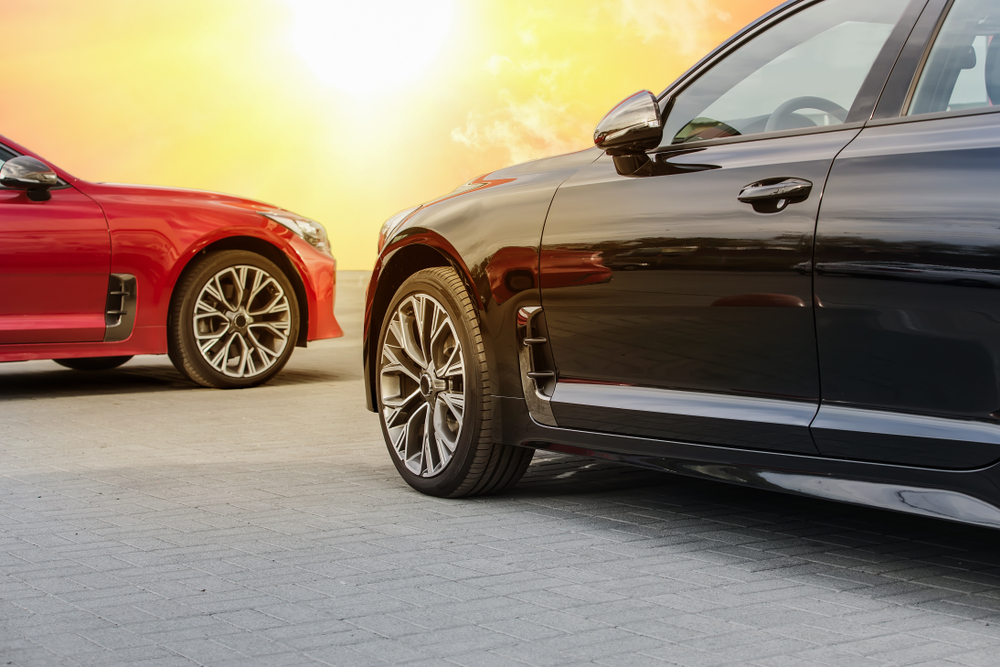
Rustproofing Cars: Knowing Your Options
By now, rust prevention should seem like a no-brainer. Still, our product reviews showed a variety of rustproofing mechanisms, from removers and converters to lubricants and undercoats. The terminology used is highly specific, and we understand it can be difficult to decide which spray type is best suited for your car.
So to help you pick, here’s a breakdown of your rustproofing options:
What Is a Rust/Corrosion Inhibitor?
Rust (or corrosion) inhibitors are preventative treatments that work by significantly slowing the rate of metal oxidation to prevent the appearance of rust. As such, any product with active ingredients that can limit oxidation (such as organic solvents or acidic solutions) can be considered as a rust inhibitor.
No matter the current level of rusting on your vehicle, we believe a formula that inhibits future rust is always the first thing you should look for when rustproofing. Why? Because there’s no lasting value in treating rust if it’s only going to reoccur the next time winter comes around. That’s why every product on our review list is a corrosion inhibitor.
Best for you: If you’re a car owner with an interest in protecting your vehicle from corrosion damage.
Rust Removers
Rust removers are applied directly to rusted areas. They work by binding to the rust and when they’re later washed off, or removed from a soak – they take the rust with it. Rust removers tend to have relatively mild chemical compositions and can work very effectively, but they often require the treatment area to be submerged in solution. This may work for smaller automotive components, but it’s impossible to soak larger car parts. They deserve honorable mention in this article but aren’t usually the best option for car owners for this reason.
Best for you: If you wish to remove existing rust from small automotive components that can be fully submerged and soaked.
Rust Converters
When submerging isn’t a viable option, a rust converter is usually a more appropriate alternative. Instead of removing rust, a converter solution chemically reacts with existing rust ions to transform them into an inert (chemically inactive) substance. Typically this is done with one of three active ingredients: tannic acid, phosphoric acid, or gallic acid, which have a body of evidence supporting their efficacy. You can then paint over the resulting solution to conceal the rust entirely.
Best for you: If you’re looking to treat existing rust on areas of your car that can’t be removed. A rust converter like Rust Reformer should be your go-to – it’s our favorite overall pick. Or, check out our list of the best Rust Converters available today.
Primers
A primer is a bonding agent which gives a heightened level of adhesion for painting a surface. Essentially, it’s a middle-man in the painting process that gives an additional layer of protection. Many rust prevention sprays available also act as a primer, allowing you to apply a topcoat of paint over the top, for a more striking visual finish.
Best for you: If you’re looking to repaint a visible area of your car and want to give yourself full rust protection. For example, with Corroseal you can paint a topcoat directly over the solution; the treatment acts as a primer to provide a protective base against corrosion.
Undercoats
In the automotive world, an undercoating typically refers to a substance that is applied to the undercarriage of your car to prevent it against road damage. Specialized undercoat products are available, but many standard rust prevention sprays can be used as an undercoat, too. Specialized undercoats are typically rubberized, or based in polyurethane, wax, paraffin, or asphalt. These are sometimes enhanced with corrosion preventative properties, but not always.
Best for you: If your primary goal is to protect the road-facing parts of your vehicle from weather or debris damage. For this purpose, 3M is the best product we’ve found – it offers a professional-grade rubberized undercoating to protect the undercarriage of your car from corrosion.
WATCH OUT: The term undercoat is often used differently when referring to other types of painting. Many people, including professionals, use the term undercoat interchangeably with primer.
Lubricant Protectants
These products are typically oil or lanolin-based and lubricate metal by smoothing the bumps between two surfaces, while simultaneously protecting the surface from air and moisture, limiting future corrosion. Lubricants prioritize function and offer more of a sticky residue than a dazzling shine.
Best for you: If you’re looking to maintain optimal car performance and prevent stiffness and squeaking while also inhibiting corrosion. In this category, Fluid Film is our go-to product.
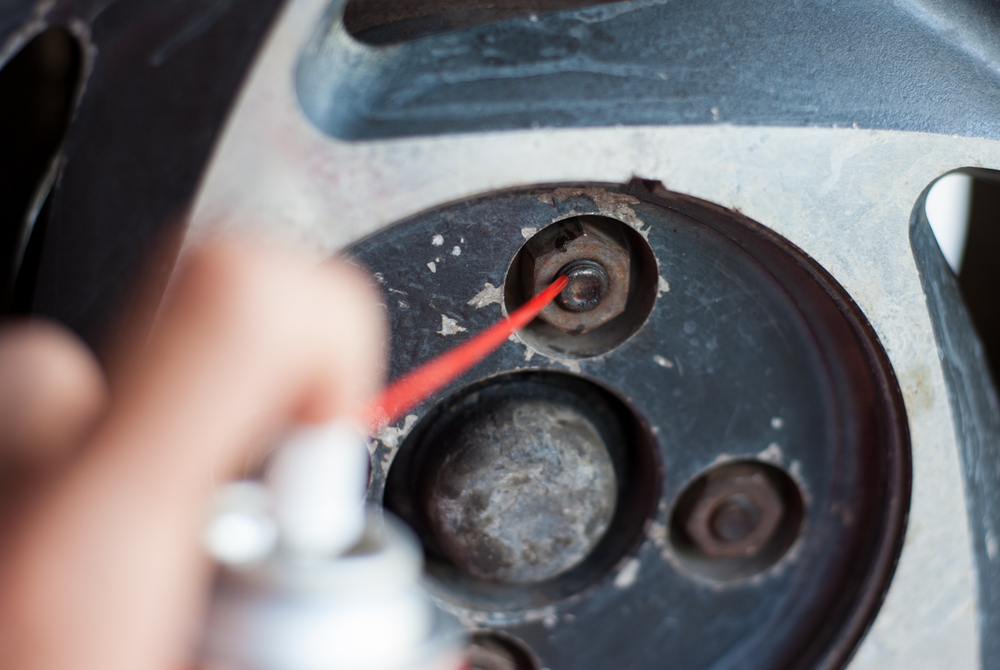
Rust Prevention Spray vs. Paint
Rust Prevention Spray
Pros:
- Gives a smooth, even coating
- Quick to apply
- Easier to reach difficult spaces (especially on the undercarriage)
Cons:
- Requires a light and steady hand
- A spray can may cause hand fatigue and cramping
- Some cans only spray effectively from an upright position
Rust Prevention Paint
Pros:
- Goes on thick
- Surface adhesion is usually better
- Easier to control (especially for straight lines)
Cons:
- Can leave visible brush strokes
- More time-consuming
- Many of the best solutions aren’t available as a paint
A middle-ground solution is to use an electric spray gun. These aren’t cheap, and you’ll need to make sure the gun head is compatible with your product of choice, too.
The good news? A spray gun is faster than either aerosol spraying or painting and can cut down your product usage by around 20%, which is a significant saving in itself. Ultimately, there’s no right or wrong here. It’s a personal preference, but absolutely something worth considering.
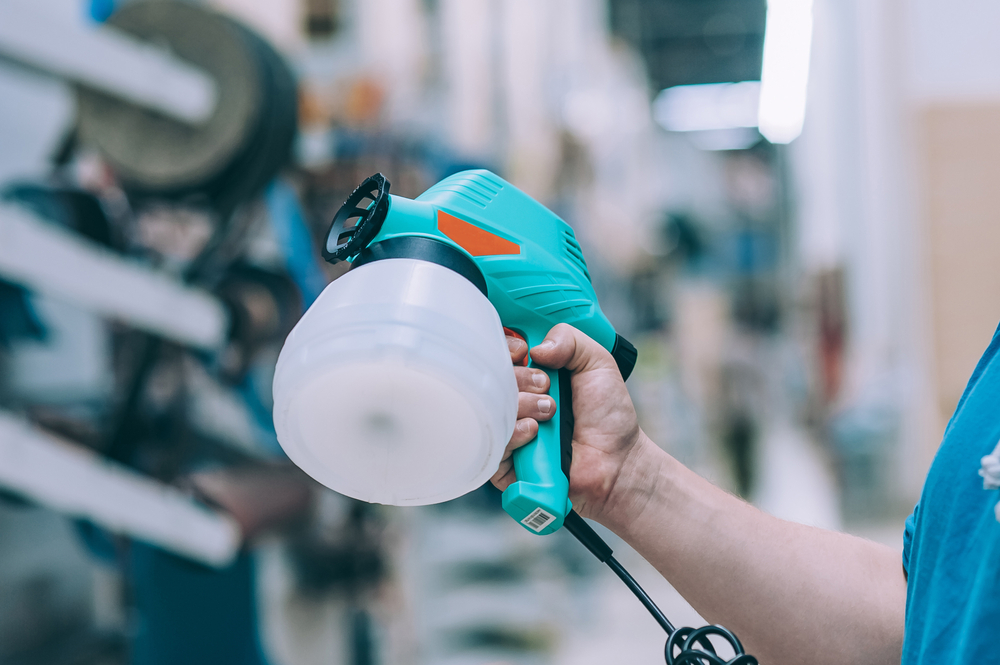
Further Considerations for DIY Rust Prevention
Now that you’re up to speed on the different types of rustproofing, you should have some idea of which products from our list are most suitable for you. But before you hit that buy button, here are a few extra considerations you should make.
Toxicity
Many of the products reviewed have a strong chemical composition (generally acids or solvents) and are often considered to be toxic, as well as flammable. They may cause long-term respiratory damage if inhaled or dermatological issues like dermatitis if they come in contact with your skin. As such, it’s essential that you wear a mask and nitrile gloves and only use in a well-ventilated area.
Ensure you pay close attention to the product safety labels and usage instructions, as not all options are beginner-friendly. For those considering a purchase for larger-scale professional jobs, we would encourage you to seek out Safety Data Sheets for the full chemical specifications of these products, which are available from the original manufacturers. That way you can ensure legal usage compliance.
PRO-TIP: disposal is an important consideration, too. Large quantities should be disposed of in the appropriate manner, which varies according to local laws.
Heat Resistance
Unless marked as ‘heat-resistant’ you should avoid applying rust prevention sprays to exhaust piping systems. Doing so won’t usually cause damage, but the heat will soon burn off the coating and you’ll be back where you started, only with a lighter wallet.
Surface Preparation
For some of the products listed above, a degree of surface preparation is required. This is how it should be done:
- Use a pressure washer or stiff bristle brush to remove loose rust and dirt from the surface area. Removing bigger flakes is important, but don’t go crazy if you’re planning to use a rust converter – that’ll do the hard work for you.
- At this stage, if you’re struggling to get a smooth enough surface, you can use sandpaper to grind down any bumpy areas – but this is by no means necessary.
- The product you’re using may require a fully clean surface for strong adhesion. In our experience, it’s not necessary to buy a specific degreaser. Instead, our favorite DIY option is isopropyl alcohol. Of course, if the metal is clean or your rust prevention spray doesn’t require a clean surface, you can skip this step.
- Apply an aftermarket rust prevention spray product, as per product instructions. Make sure you take heed of toxicity warnings and give the treatment time to cure before you take it out on the road.
Frequently Asked Questions
How Does Rust Form?
Rust is the visible manifestation of metal oxidation. It’s a natural phenomenon that occurs gradually when metals (steel and iron) are exposed to oxygen and water. As there’s moisture in the air we breathe, corrosion takes place even in environments without visible water, albeit very slowly. The more moisture, the faster the corrosion. Rust is such a big issue for car owners because vehicles are routinely exposed to moisture, even in drier climates. Plus, the outer paintwork on vehicles is prone to chips and splits, and this provides an environment suited for moisture to bond with the metal, allowing rust to form.
For more insight into the chemistry behind the metal rusting process, check out this video from Reactions:
PRO-TIP: rust typically affects the undercarriage of cars first because of their increased exposure to moisture. If you’re looking to buy a car you should always ask to have it lifted so that you can see the underside and check for a rust problem, even if the car body looks flawless. The frame rails, well wheels, exhaust, and the suspension are common hotspots.
Will Rust Spread if Kept Dry?
No. Rust doesn’t spread through contact – this is a common misconception. If existing rust is kept clean and dry, it won’t cause the nearby metal to also rust. The reason that rust may appear to spread is that nearby areas of metal are typically exposed to the same levels of moisture.
How Does Anti-Rust Spray Work?
Generally speaking, anti-rust spray works by providing a coating to protect the vulnerable metal underneath, preventing exposure to moisture and drastically slowing down the level of corrosion that can take place. There are several different mechanisms of action that prevent or treat rust, as detailed in our Rustproofing Cars: Know Your Options guide.
What Is the Best Rust Protection for Cars?
We believe the best way to protect your car from rust is to follow these four simple steps:
- Regularly wash your car to remove any salt, sand, or dirt buildup
- Store your vehicle indoors or under a cover to limit exposure to excess moisture
- Take the time to do a monthly check for signs of rust (undercarriage rusting typically appears first)
- Apply one of the best rust prevention sprays
Prevention Is the Best Cure
While your car may feel like the batmobile right now, neglecting rust prevention is a sure-fire way to turn it into a hunk of junk. In our expert opinion, using a rust prevention spray is the most cost-effective and beginner-friendly method of keeping your vehicle looking good and performing better.
After reading our guide, you’ve got all the information you need to keep your paintwork shining in the sun, and still protected from the rain. Consistency is important, but this needn’t be a source of stress. Consider it a regular opportunity to marvel at your handiwork. Plus, just a ten- minute monthly check could save you countless dollars and hours in the long-term.


